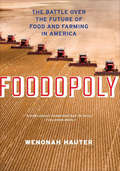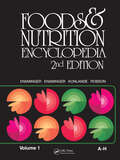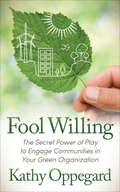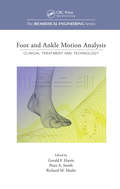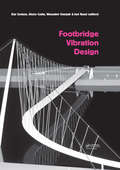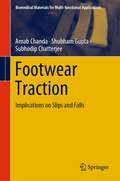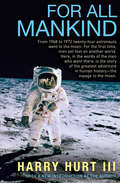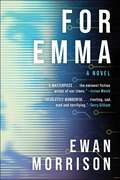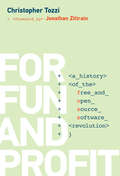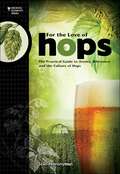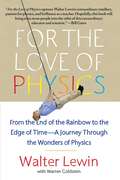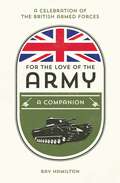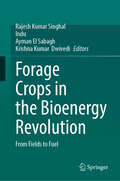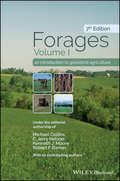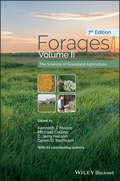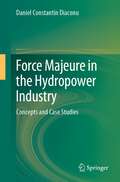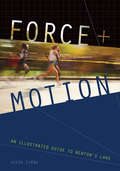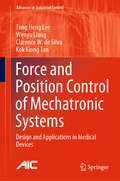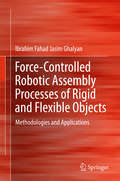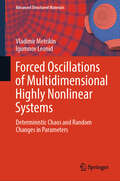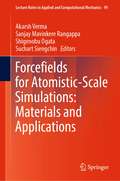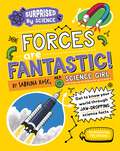- Table View
- List View
Foodopoly: The Battle Over the Future of Food and Farming in America
by Wenonah Hauter&“A meticulously researched tour de force&” on politics, big agriculture, and the need to go beyond farmers&’ markets to find fixes (Publishers Weekly). Wenonah Hauter owns an organic family farm that provides healthy vegetables to hundreds of families as part of the Community Supported Agriculture (CSA) movement. Yet, as a leading healthy-food advocate, Hauter believes that the local food movement is not enough to solve America&’s food crisis and the public health debacle it has created. In Foodopoly, she takes aim at the real culprit: the control of food production by a handful of large corporations—backed by political clout—that prevents farmers from raising healthy crops and limits the choices people can make in the grocery store. Blending history, reporting, and a deep understanding of farming and food production, Foodopoly is a shocking, revealing account of the business behind the meat, vegetables, grains, and milk most Americans eat every day, including some of our favorite and most respected organic and health-conscious brands. Hauter also pulls the curtain back from the little-understood but vital realm of agricultural policy, showing how it has been hijacked by lobbyists, driving out independent farmers and food processors in favor of the likes of Cargill, Tyson, Kraft, and ConAgra. Foodopoly shows how the impacts ripple far and wide, from economic stagnation in rural communities to famines overseas, and argues that solving this crisis will require a complete structural shift—a change that is about politics, not just personal choice.
Foods & Nutrition Encyclopedia, 2nd Edition, Volume 1
by Marion Eugene Ensminger Audrey H. EnsmingerFoods and Nutrition Encyclopedia, 2nd Edition is the updated, expanded version of what has been described as a "monumental, classic work." This new edition contains more than 2,400 pages; 1,692 illustrations, 96 of which are full-color photographs; 2,800 entries (topics); and 462 tables, including a table of 2,500 food compositions. A comprehensive index enables you to find information quickly and easily.
Foods: Experimental Perspectives
by Margaret McWilliamsPreparing aspiring professionals with clearly written, in-depth scientific coverage of food and its safe preparation. Never before has food received so much attention. Today's news shines a spotlight on food, food science, and nutrition ― beckoning today’s readers to an exciting career in this essential industry. Foods: Experimental Perspectives, Eighth Edition blends the underlying science with discussion of GMOs, sustainability, healthy and trendy food choices, and other current consumer issues. Its clear presentation of the science guides readers through complex concepts that influence practices in food preparation and product development. The study of foods begins with an in-depth presentation of carbohydrates and food sources, followed by a careful look at lipids, and ultimately proteins and their principal sources. Aspects of the food supply, including safety, preservation, and additives are then examined. Discussion of the research process and evaluation techniques used in food research and product development close the text. Professional vocabulary is developed through margin definitions and a substantial glossary, while other learning aids ― chapter objectives, summaries, study questions, "Food for Thought" boxes, and photos ― support the reader's journey through the exciting look at food, food science, and food safety.
Fool Willing: The Secret Power of Play to Engage Communities in Your Green Organization
by Kathy OppegardImagine what having more advocates could do for environmental organization: more engaged volunteers, more political wins for conservation, more financial support, and more enthusiastic collaborations. The U.S. is fortunate to have people from many different cultures and ethnicities, yet so many of these good folks have not been invited to full participation in the green movement.Fool Willing is a playful, practical guide for welcoming and including all communities at the “green table.” Putting a happy little kid, a salsa-dancing event planner, and Jane Goodall in the same room, Fool Willing would be what they would write together. Its light-hearted voice invites readers to bring playfulness and practicality as they make advances for people and the planet. Author and certified Martha Beck Life Coach, Kathy Oppegard helps people in environmental organizations bring communities into full participation in their organizations and volunteer teams. She has coordinated hundreds of volunteers for multiple events. Dig in and get ready to have more fun and be more effective as you grow your community in your green organization today!
Foot and Ankle Motion Analysis: Clinical Treatment and Technology
by Gerald F. Harris Peter A. SmithHuman motion analysis or gait analysis is used throughout the country and the world in clinics for pre-surgical planning and postsurgical follow-up. Only recently have technological advances truly begun to meet medical needs by supplying more accurate analytical data from which to make educated assessments of dynamic foot and ankle pathology. A com
Footbridge Vibration Design
by Elsa Caetano Wasoodev Hoorpah Joel Raoul Álvaro CunhaFootbridge Vibration Design presents new approaches, numerical tools and experimental tools for assessing and controlling pedestrian effects. Moreover, it includes a number of reference cases dealing with design and control. Focussed on the translation of these findings into practical recommendations, guidelines, codes and design tools for the desi
Footprints On The Moon
by Alexandra SiyOn July 20, 1969, at 3:16 p.m., Commander Neil Armstrong brought the lunar module, Eagle , to a safe landing on the Moon. Millions of television viewers on Earth watched breathlessly as he then became the first man to set foot on the Moon. This amazing achievement was years, even centuries, in the making. The Moon and the heavens have intrigued mankind since ancient times. <P><P>FOOTPRINTS ON THE MOON chronicles the spirit and determination of visionaries from Galileo to John F. Kennedy, whose dream of reaching the Moon was finally and superbly realized through the efforts of the Apollo missions. <P><P> With a compelling and thoroughly researched text, the great vision of the scientists, engineers, and astronauts who struggled to make the dream a reality is brought into sharp focus. The book brings to light great triumphs and tragedies. Readers will learn about the years of determination, experimentation, and risk that gave rise to many space explorations, including 17 Apollo missions. Today the Moon is less of a mystery than in ancient times, but it is still a wonder. <P><P> Breathtaking photographs--many from NASA--portray the indescribable beauty of outer space, the Moon, and the wonder of mankind's inspiring vision.
Footwear Traction: Implications on Slips and Falls (Biomedical Materials for Multi-functional Applications)
by Arnab Chanda Shubham Gupta Subhodip ChatterjeeThis book discusses the science of footwear traction and its relationship with slips and falls. It presents a detailed introduction to slips and falls and how crucial footwear traction is to avoid such incidents. The book covers ergonomics involved in the development of tread designs and the study of their effect on traction across footwear and systematically modified shoes. It discusses characterization techniques employed in the study of footwear traction across normal gait activities, such as walking and running and in sports, such as sprinting, basketball, and football. The book also covers the role of flooring and slippery contaminants on footwear traction and its generalizability. Additionally, the book also presents how the wear of footwear outsoles may reduce the traction at the shoe-floor and lead to slips and falls. It also discusses the challenges with the existing footwear traction testing methods, and the latest developments in this niche area are highlighted. The book is a valuable reference for researchers and professionals interested in ergonomics, footwear technology, manufacturing engineering, safety engineering, and design engineering and its allied fields.
For All Mankind
by Harry Hurt III&“Far more than a history of lunar exploration . . . [Hurt] is at his best in the deft sketches of the astronauts—as they were and as they became.&”—Chicago Tribune Between December 1968 and December 1972, twenty-four men captured the imagination of the world as they voyaged to the moon. In For All Mankind, Harry Hurt III presents a dramatic, engrossing, and expansive account of those journeys. Based on extensive research and exclusive interviews with the Apollo astronauts, For All Mankind remains one of the most comprehensive and revealing firsthand accounts of space travel ever assembled. In their own words, the astronauts share the sights, sounds, thoughts, fears, hopes, and dreams they experienced during their incredible voyages. In a compelling narrative structured as one trip to the moon, Harry Hurt recounts all the drama and danger of the lunar voyages, from the anxiety of the astronauts&’ prelaunch procedures through the euphoria of touchdown on the lunar surface. Updated with a new introduction by the author for the 50th anniversary of the Apollo 11 moon landing, For All Mankind is both an extraordinary adventure story and an important historical document. &“Hurt&’s timely book is like an instant replay of the dramatic moon flight years . . . Hurt tells us of the hardships and the successes of the Apollo program, the remarkable journey to the moon, of the astronauts and technicians who made it possible and the goals of the nation in space.&”—Houston Chronicle &“The meat here lies in the lunar voyage itself, an irresistible mix of danger, courage, tedium, and spectacle, evoked with unprecedented detail by those who went there.&”—Kirkus Reviews
For Emma: A Novel
by Ewan MorrisonA year after Emma Henson, a young, genius bio-tech scientist, dies in a covert AI brain-chip experiment, her father Josh has nothing left to live for and vows to get revenge on the Silicon Valley CEO responsible. Josh has thirty days to make his home-made bombs and to say goodbye to his life. To give himself courage in the countdown, he records daily video messages to his lost "Em." He is fueled by the horrific memories of Em&’s death—her body and brain devoured by the AI "infinity" system in its quest for immortality. Memories flood him as he searches for the moments in Emma&’s short life where he could have been a better father and saved her. As he grapples with constructing and testing his DIY bombs, his thirty days start to run out, and Emma&’s voice returns to him, speaking with him as he sets to complete his mission. He worries that he&’s gone insane—he doubts if he can see the violent act through—but Emma&’s voice insists he continue on his path toward murder and mayhem. Josh tries to resist his daughter&’s voice as it attempts to take full control of his body. But is it even her? Or is it a ghost, a psychotic delusion or the AI system that is controlling him? Inspired by the real-life Brain Chip Implant experiments (Musk/Neuralink) and the technogothic tradition (Frankenstein, Dr Jekyll and Mr Hyde, The Island of Dr Moreau), For Emma is a tale of possession by a new force unleashed by science. It is a warning for the future but also an intimate, heart-breaking study of the love between a father and daughter and of the madness that grief can drive us to.
For Fun and Profit: A History of the Free and Open Source Software Revolution (History of Computing)
by Christopher TozziThe free and open source software movement, from its origins in hacker culture, through the development of GNU and Linux, to its commercial use today.In the 1980s, there was a revolution with far-reaching consequences—a revolution to restore software freedom. In the early 1980s, after decades of making source code available with programs, most programmers ceased sharing code freely. A band of revolutionaries, self-described “hackers,” challenged this new norm by building operating systems with source code that could be freely shared. In For Fun and Profit, Christopher Tozzi offers an account of the free and open source software (FOSS) revolution, from its origins as an obscure, marginal effort by a small group of programmers to the widespread commercial use of open source software today. Tozzi explains FOSS's historical trajectory, shaped by eccentric personalities—including Richard Stallman and Linus Torvalds—and driven both by ideology and pragmatism, by fun and profit.Tozzi examines hacker culture and its influence on the Unix operating system, the reaction to Unix's commercialization, and the history of early Linux development. He describes the commercial boom that followed, when companies invested billions of dollars in products using FOSS operating systems; the subsequent tensions within the FOSS movement; and the battles with closed source software companies (especially Microsoft) that saw FOSS as a threat. Finally, Tozzi describes FOSS's current dominance in embedded computing, mobile devices, and the cloud, as well as its cultural and intellectual influence.
For The Love of Hops: The Practical Guide to Aroma, Bitterness and the Culture of Hops (Brewing Elements)
by Stan HieronymusHops, once a marginal player in modern brewing, have risen to iconic status thanks to the American craft beer revolution. In For the Love of Hops Stan Hieronymus explores the rich history, cultivation, and science behind this essential brewing ingredient. Hops have a long and mysterious past. Hieronymus unpacks their story with a discerning eye, separating fact from myth through deep research into historical records, scientific studies, and interviews with experts and growers. His work offers a compelling, wide-ranging look at how hops evolved from a supporting player to a defining feature in beer. From field to fermenter, the path of the hop is anything but simple. Hieronymus blends technical details—such as hop anatomy and growth cycles—with firsthand stories from farming families who&’ve cultivated hops for generations. He leads readers through historic and emerging growing regions: Germany, the Czech Republic, England, the U.S., Australia, and New Zealand. Along the way, he illustrates the challenges growers face, from crop diseases to shifting market demands. Hieronymus also provides a catalog of over 100 hop varieties, from noble Old World types like Saaz and Tettnang to bold New World stars like Cascade, Amarillo, and Nelson Sauvin. Each entry includes vital stats and insights on flavor, aroma, and usage. Once harvested, hops unlock a brewer&’s full creative range. The book dives into their essential compounds—alpha and beta acids—and how they influence bitterness, flavor stability, and aroma. Hieronymus breaks down a variety of hopping techniques, including: Early &Late Additions – How timing shapes flavor. First Wort Hopping – Adding hops before the boil. Hop Bursting & Continuous Hopping – Techniques for maximizing aroma. Dry Hopping – A full chapter dedicated to this aromatic art, from 19th-century England to today&’s cutting-edge methods like hop rockets and torpedoes. He also explores how the perception of bitterness varies by individual and how exposure to heavily hopped beers can change our taste preferences—a phenomenon known as the &“lupulin shift.&” The development and meaning of IBUs (International Bitterness Units) are explained in context, helping demystify a widely misunderstood metric. To ground theory in practice, the book features 16 beer recipes from renowned breweries in the U.S., Belgium, Germany, England, New Zealand, and more. These recipes reveal how top brewers use hops to shape character and balance.For the Love of Hops is both educational and inspiring—a must-read for brewers, beer lovers, and anyone interested in the flower that changed beer forever.
For the Love of Physics: From the End of the Rainbow to the Edge Of Time - A Journey Through the Wonders of Physics
by Walter Lewin“YOU HAVE CHANGED MY LIFE” is a common refrain in the emails Walter Lewin receives daily from fans who have been enthralled by his world-famous video lectures about the wonders of physics. “I walk with a new spring in my step and I look at life through physics-colored eyes,” wrote one such fan. When Lewin’s lectures were made available online, he became an instant YouTube celebrity, and The New York Times declared, “Walter Lewin delivers his lectures with the panache of Julia Child bringing French cooking to amateurs and the zany theatricality of YouTube’s greatest hits.” For more than thirty years as a beloved professor at the Massachusetts Institute of Technology, Lewin honed his singular craft of making physics not only accessible but truly fun, whether putting his head in the path of a wrecking ball, supercharging himself with three hundred thousand volts of electricity, or demonstrating why the sky is blue and why clouds are white. Now, as Carl Sagan did for astronomy and Brian Green did for cosmology, Lewin takes readers on a marvelous journey in For the Love of Physics, opening our eyes as never before to the amazing beauty and power with which physics can reveal the hidden workings of the world all around us. “I introduce people to their own world,” writes Lewin, “the world they live in and are familiar with but don’t approach like a physicist—yet.” Could it be true that we are shorter standing up than lying down? Why can we snorkel no deeper than about one foot below the surface? Why are the colors of a rainbow always in the same order, and would it be possible to put our hand out and touch one? Whether introducing why the air smells so fresh after a lightning storm, why we briefly lose (and gain) weight when we ride in an elevator, or what the big bang would have sounded like had anyone existed to hear it, Lewin never ceases to surprise and delight with the extraordinary ability of physics to answer even the most elusive questions. Recounting his own exciting discoveries as a pioneer in the field of X-ray astronomy—arriving at MIT right at the start of an astonishing revolution in astronomy—he also brings to life the power of physics to reach into the vastness of space and unveil exotic uncharted territories, from the marvels of a supernova explosion in the Large Magellanic Cloud to the unseeable depths of black holes. “For me,” Lewin writes, “physics is a way of seeing—the spectacular and the mundane, the immense and the minute—as a beautiful, thrillingly interwoven whole.” His wonderfully inventive and vivid ways of introducing us to the revelations of physics impart to us a new appreciation of the remarkable beauty and intricate harmonies of the forces that govern our lives.
For the Love of the Army: A Celebration of the British Armed Forces
by Ray HamiltonFrom the heroes, regiments and famous battles of the British Army’s impressive history to the service people of today, this book celebrates the achievements and ongoing importance of the UK’s land force. It also explores the skills, weaponry and equipment necessary to keep the Army battle-ready and able to face any challenge.
For the Love of the Army: A Celebration of the British Armed Forces
by Ray HamiltonFrom the heroes, regiments and famous battles of the British Army’s impressive history to the service people of today, this book celebrates the achievements and ongoing importance of the UK’s land force. It also explores the skills, weaponry and equipment necessary to keep the Army battle-ready and able to face any challenge.
Forage Crops in the Bioenergy Revolution: From Fields to Fuel
by Rajesh Kumar Singhal Ayman El Sabagh Indu Krishna Kumar DwivediThis book delves into the popular "Food vs. Fuel" arguments and examines the complicated interplay between biofuel and agricultural markets. It provides information on forage crops as potential third-generation sources of bioenergy, and their cultivation practices. The areas covered include methodologies to enhance production efficiency of bioenergy, metabolism involved in cellulosic ethanol production, influence of policy and technical implementation, and the consequent impact on biofuels. The discussion of current difficulties impeding the expansion of the cellulosic biofuel business, as well as potential solutions are discussed as well. This book also covers case studies describing the present biofuel policies and its consequences on both the energy as well as agricultural sectors, as well as analysis of the current and growing biofuel market. The gathered information in the book is an excellent source for phenotyping, trait improvement, and developing future crop stress-management strategies and models. Students, scientists, policymakers, and investors in the bioenergy business will find this book to be a useful resource. Also, it serves as an excellent reference book for agriculturists, plant scientists, climatologists, and research scholars.
Forages, Volume 1: An Introduction to Grassland Agriculture
by Michael Collins C. Jerry Nelson Kenneth J. Moore Robert F. BarnesForages, Volume I, Seventh Edition is the most comprehensive text available for teachers of undergraduate Forages courses. This edition will provide students with a good balance of scientific principles, to aid in integrating the concepts they learn, and practical information on forage identification, plant characteristics, management, and utilization that can be used by forage management practitioners. Grassland ecosystems are extremely complex, including the plant/animal interface as well as the soil/climate/forage interface and the text must support understanding and integration of all of these considerations. The coverage of the science behind the plant characteristics and responses make the book applicable in many parts of the world, while other region-specific management information relates mainly to North America.This edition has been updated to address emerging areas of study, including the use of forage plants as bioenergy crops. The editors also address the renewed national interest in environmental issues such as water quality, global climate change and eutrophication in the Gulf. This edition also addresses the role of forages for wildlife habitat and food sources, another area of increased interest in recent years. These revisions respond to the generational change taking place among forage scientists and teachers in recent years.
Forages, Volume 2: The Science of Grassland Agriculture (Special Publication Ser. #Vol. 22)
by Michael Collins C. Jerry Nelson Kenneth J. Moore Daren D. RedfearnForages: The Science of Grassland Agriculture, 7th Edition, Volume II will extensively evaluate the current knowledge and information on forage agriculture.Chapters written by leading researchers and authorities in grassland agriculture are aggregated under section themes, each one representing a major topic within grassland science and agriculture. This 7th edition will include two new additional chapters covering all aspects of forage physiology in three separate chapters, instead of one in previous editions. Chapters will be updated throughout to include new information that has developed since the last edition.This new edition of the classic reference serves as a comprehensive supplement to An Introduction to Grassland Agriculture, Volume I.
Force Majeure in the Hydropower Industry: Concepts and Case Studies
by Daniel Constantin DiaconuThis book aims to highlight the particular situation faced by certain hydropower companies by the fact that they cannot fulfil their contracts due to force majeure. The first part of this book will be an analysis of how water is used in electricity production. It is important to point out that all types of energy sources use water, to a different extent, of course, and that its spatial and temporal availability is very important. The focus will be on hydropower, presenting the current situation at the global level, and the effect of reducing the amounts of water in the river system.The second part is based on the presentation of the concept of force majeure and the ways of presenting and drafting it in a contract. Many disputes or the success of a contract depended heavily on the provisions of this article of the contract. Obviously, there are also situations in which the signatory parties abuse or are not protected by these provisions of force majeure. Starting from a few brief examples from the international level, we reach a wide discussion of the situation created in Romania, when the largest supplier of electricity produced on the basis of water terminates several contracts invoking force majeure. The manner in which the opinion of the parties involved is presented to the court is analyzed and presented in detail.
Force and Motion: An Illustrated Guide to Newton's Laws
by Jason ZimbaIsaac Newton developed three laws of motion that govern the everyday world. These laws are usually presented in purely mathematical forms, but Jason Zimba breaks with tradition and treats them visually. This unique approach allows students to appreciate the conceptual underpinnings of each law before moving on to qualitative descriptions of motion and, finally, to the equations and their solutions.Zimba has organized the book into seventeen brief and well-sequenced lessons, which focus on simple, manageable topics and delve into areas that often cause students to stumble. Each lesson is followed by a set of original problems that have been student-tested and refined over twenty years. Zimba illustrates the laws with more than 350 diagrams, an innovative presentation that offers a fresh way to teach the fundamentals in introductory physics, mechanics, and kinematics courses.
Force and Position Control of Mechatronic Systems: Design and Applications in Medical Devices (Advances in Industrial Control)
by Tong Heng Lee Kok Kiong Tan Clarence W. de Silva Wenyu LiangForce and Position Control of Mechatronic Systems provides an overview of the general concepts and technologies in the area of force and position control. Novel ideas and innovations related to this area are presented and reported in detail, and examples of applications in medical technology are given.The book begins by introducing force sensing, and modelling of contacting objects. In then moves steadily through a variety of topics, including:• disturbance observer-based force estimation;• force-based supervisory control;• stabilization systems;• controller design; and• control of tube insertion procedures.This book will be of interest to researchers, engineers and students interested in force control, particularly those with a focus on medical applications of these ideas.Advances in Industrial Control reports and encourages the transfer of technology in control engineering. The rapid development of control technology has an impact on all areas of the control discipline. The series offers an opportunity for researchers to present an extended exposition of new work in all aspects of industrial control.
Force-Controlled Robotic Assembly Processes of Rigid and Flexible Objects
by Ibrahim Fahad Jasim GhalyanThis book provides comprehensive and integrated approaches for rigid and flexible object assembly. It presents comparison studies with the available force-guided robotic processes and covers contact-state modeling, scheme control strategies, and position searching algorithms. Further, it includes experimental validations for different assembly situations, including those for the assembly of industrial parts taken from the automotive industry.
Forced Oscillations of Multidimensional Highly Nonlinear Systems: Deterministic Chaos and Random Changes in Parameters (Advanced Structured Materials #222)
by Vladimir Metrikin Igumnov LeonidThis book highlights the presentation of methods for studying oscillations under external periodic influence and random changes in parameters in dynamic systems with nonlinearities that have discontinuities and kinks. The analysis of dynamic systems is based on effective approaches and algorithms of the method of point mappings of Poincaré surfaces, developed by the Nizhny Novgorod Scientific School of academician A.A. Andronov. Considerable attention is paid to the study of the general picture of the possible behavior of systems and their use in solving various applied problems. Using specific examples, it is found that this research approach allows not only to advance in the study of known nonlinear features but also to discover new effects and applications. The presentation is illustrated by numerous specific examples of oscillatory strongly nonlinear systems with discontinuous nonlinearities or piecewise-continuous nonlinearities. A separate chapter is devoted to the development and use of the point mapping method for random changes in the parameters of dynamic systems, as well as in dynamic systems subject to external seismic loads. The book is intended for scientists and engineers who are engaged in research and practice activities related to the theory of nonlinear oscillations and its applications, as well as graduate students and senior undergraduate students in relevant majors.
Forcefields for Atomistic-Scale Simulations: Materials and Applications (Lecture Notes in Applied and Computational Mechanics #99)
by Suchart Siengchin Sanjay Mavinkere Rangappa Akarsh Verma Shigenobu OgataThis book describes the forcefields/interatomic potentials that are used in the atomistic-scale and molecular dynamics simulations. It covers mechanisms, salient features, formulations, important aspects and case studies of various forcefields utilized for characterizing various materials (such as nuclear materials and nanomaterials) and applications. This book gives many help to students and researchers who are studying the forcefield potentials and introduces various applications of atomistic-scale simulations to professors who are researching molecular dynamics.
Forces are Fantastic! (Surprised by Science #3)
by Sabrina Rose Science GirlBe surprised by the astonishing science of forces, with Sabrina Rose, AKA Science Girl, the internet's most inspiring curator of facts and observations of our wonderful world - making it easy for all readers to come to love science!Surprised by Science: Forces are Fantastic brings an attention-grabbing and accessible set of facts about forces and physics to life! Doing what she's famous for online, Sabrina Rose dives into the most surprising details of the world of forces to explore the science at work. From black holes to gravity in space; from magnets in navigation to friction in storms - this series is perfect for inquisitive children age 7 and up, and all fans of Science Girl.Surprised by Science is a series of books that takes the inspiring communication and research skills of Science Girl's hugely popular platform and distills it on the page, with funny and engaging illustrations by Pipi Sposito paired with photos of the real-life science in action. The series includes: Electricity is Epic!; Plants are Powerful!; Forces are Fantastic!; Sound is Sensational!; Animals are Awesome!; Human Bodies are Brilliant!
